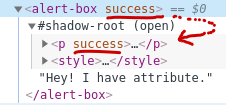Propagating Attributes
To facilitate styling based on attributes, tag-components propagates every attribute defined in the custom element to the root element of shadow tree.
<component name="alert-box" extends="p"><style>p {background-color: #eae2b7;color: #003049;padding: 10px;}p[success] {color: #d62828;font-weight: bold;}</style></component><alert-box>Normal box without attribute</alert-box><alert-box success>Hey! I have attribute.</alert-box>
You can see the <p> element has the same attribute success defined in <alert-box>. tag-components propagates so you can easely add styles based on this attribute. The other way would be to style based on :host[success].

Defining template
Let's say you want to define your own template for your component, how attributes propagation will work?
<component name="my-alert"><template><p super><slot /></p></template><style>p {background-color: #eae2b7;color: #FFF;padding: 10px;}p[super] {background-color: #6B4E71;}p[success] {font-weight: bold;box-shadow: 0 0px 10px 6px #9ecaed;}</style></component><my-alert>native</my-alert><my-alert success>propagating attributes</my-alert>
Examining the DOM you can see the attributes passed in my-alert will propagate to
the root element (in this case p). Also, since the root element already has an attribute,
it will merge maintaining both.
